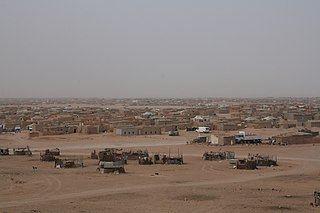
The economy of Rwanda has undergone rapid industrialisation due to a successful governmental policy. It has a mixed economy. Since the early-2000s, Rwanda has witnessed an economic boom, which improved the living standards of many Rwandans. The President of Rwanda, Paul Kagame, has noted his ambition to make Rwanda the "Singapore of Africa". The industrial sector is growing, contributing 16% of GDP in 2012.

The World Food Programme (WFP) is an international organization within the United Nations that provides food assistance worldwide. It is the world's largest humanitarian organization and the leading provider of school meals. Founded in 1961, WFP is headquartered in Rome and has offices in 87 countries. In 2023 it supported over 152 million people, and it is present in more than 120 countries and territories.
Operation Blessing International Relief and Development Corporation (OBI) is an Evangelical Christian organization headquartered in Virginia Beach, Virginia, United States. Founded in 1978, OBI operates in more than 90 countries, focusing on disaster relief, medical aid, clean water, hunger relief, community development, and orphan care programs.
Famine relief is an organized effort to reduce starvation in a region in which there is famine. A famine is a phenomenon in which a large proportion of the population of a region or country are so undernourished that death by starvation becomes increasingly common. In spite of the much greater technological and economic resources of the modern world, famine still strikes many parts of the world, mostly in the developing nations.
Many countries and international organizations offered the United States relief aid in the wake of Hurricane Katrina.
The North Korean famine (Korean: 조선기근), also known as the Arduous March, was a period of mass starvation together with a general economic crisis from 1994 to 1998 in North Korea. During this time there was an increase in defection from North Korea which peaked towards the end of the famine period.

Ambassador Josette Sheeran is a decorated diplomat, humanitarian, entrepreneur and technology leader.
Various international and local diplomatic and humanitarian efforts in the Somali Civil War have been in effect since the conflict first began in the early 1990s. The latter include diplomatic initiatives put together by the African Union, the Arab League and the European Union, as well as humanitarian efforts led by the Office for the Coordination of Humanitarian Affairs (OCHA), UNICEF, the World Food Programme (WFP), the Puntland Maritime Police Force (PMPF) and the Somali Red Crescent Society (SRCS).

The 2007 Jakarta flood was a major flood in Jakarta, the capital of Indonesia and affected several other areas around the city, such as West Java and Banten. The flood, beginning on February 2, 2007 was a result of heavy rain, deforestation in areas south of the city, and waterways clogged with debris. The flood is considered the worst in the last three centuries, including the 1996 and 2002 Jakarta floods, which killed 10 and 25 people respectively.

The Sahrawi refugee camps, also known as the Tindouf camps, are a collection of refugee camps set up in the Tindouf Province, Algeria, in 1975–76 for Sahrawi refugees fleeing from Moroccan forces, who advanced through Western Sahara during the Western Sahara War. With most of the original refugees still living in the camps, the situation is among the most protracted in the world.
Since the 1980s Saudi Arabia has provided foreign assistance to many countries and organizations.

Extremely Severe Cyclonic Storm Nargis was an extremely destructive and deadly tropical cyclone that caused the worst natural disaster in the recorded history of Myanmar during early May 2008. The cyclone made landfall in Myanmar on Friday, 2 May 2008, sending a storm surge 40 kilometres up the densely populated Irrawaddy delta, causing catastrophic destruction and at least 138,373 fatalities. The Labutta Township alone was reported to have 80,000 dead, with about 10,000 more deaths in Bogale. There were around 55,000 people missing and many other deaths were found in other towns and areas, although the Myanmar government's official death toll may have been under-reported, and there have been allegations that government officials stopped updating the death toll after 138,000 to minimise political fallout. The feared 'second wave' of fatalities from disease and lack of relief efforts never materialised. Damage was at 13 trillion kyat (US$15.3 billion), making Nargis the costliest tropical cyclone on record in the North Indian Ocean at the time, before that record was broken by Amphan in 2020.
Fill the Cup is a campaign of the United Nations World Food Programme (WFP), the world's largest humanitarian aid agency. In 2009, WFP plans to feed over 100 million people in 77 of the world's poorest countries. "Fill the Cup" aims to use the symbol of the Red Cup to raise awareness of global hunger, specifically involving hungry school children. About 59 million primary school age children attend school hungry across the developing world, with 23 million of them in 45 African countries.

Operation USA is a non-profit humanitarian organization supporting health, education, and relief programs at home and abroad. The Organization is privately funded, receiving no assistance from the United States federal government. OPUSA had a revenue of over $2.6 million in the fiscal year 2019, and since 1979 has delivered more than $400 million in aid to 100 countries.
Purchase for Progress (P4P) is an initiative of the United Nations World Food Programme (WFP), involving over 500 partnerships, including Bill & Melinda Gates Foundation, the Howard G. Buffett Foundation, FAO, ACDI/VOCA, TechnoServe and others. Launched in September 2008 as a five-year pilot, P4P sought to explore programming and procurement modalities with the greatest potential to stimulate agricultural and market development in ways that maximized benefits to smallholder farmers. The program, largely developed by the eleventh Executive Director of the WFP, Josette Sheeran, arose as the WFP desired to purchase food in a way that was part of the "solution to hunger". These efforts are aligned with recommendations issued by the UN Committee on Economic, Social and Cultural Rights that call for an establishment of programs in support of socially vulnerable groups. and to the Zero Hunger Challenge launched by the UN Secretary-General Ban Ki-moon. Special UN Reporter 2012–2014, Olivier De Schutter, claimed that public procurement systems favour economically strong bidders, thus excluding smallholder farmers. His conclusion was that public procurement schemes supportive of smallholders could have "powerful impacts on the reduction of rural poverty." P4P is built upon this very principle as it enables low-income farmers to supply food to the WFP's operations. Eventually, the transaction can be regulated by a forward contract, with the farmer agreeing to sell in the future a certain amount of output at a fixed price. Essentially, the P4P program aims to create a wide and sophisticated market for commodities in developing countries.

Occurring between July 2011 and mid-2012, a severe drought affected the entire East African region. Said to be "the worst in 60 years", the drought caused a severe food crisis across Somalia, Djibouti, Ethiopia and Kenya that threatened the livelihood of 9.5 million people. Many refugees from southern Somalia fled to neighboring Kenya and Ethiopia, where crowded, unsanitary conditions together with severe malnutrition led to a large number of deaths. Other countries in East Africa, including Sudan, South Sudan and parts of Uganda, were also affected by a food crisis.

By the end of February 2011, medical supplies, fuel and food were dangerously low in Libya. On 25 February, the International Committee of the Red Cross launched an emergency appeal for US$6,400,000 to meet the emergency needs of people affected by the violent unrest in Libya. On 2 March, the ICRC's director general reminded everyone taking part in the violence that health workers must be allowed to do their jobs safely.

Street King was a flavored energy drink created by American rapper Curtis “50 Cent” Jackson and Pure Growth Partners, CEO Chris Clarke.

There were 735.1 million malnourished people in the world in 2022, a decrease of 58.3 million since 2005, despite the fact that the world already produces enough food to feed everyone and could feed more than that.

Intense Tropical Cyclone Japhet was a damaging tropical cyclone that affected southeast Africa in March 2003. It developed on February 25 near the southwest coast of Madagascar, and initially moved to the northwest before turning to the southwest. With favorable conditions for development, Japhet quickly intensified in the Mozambique Channel, reaching maximum winds of 175 km/h (109 mph), sustained over 10 minutes. After stalling briefly, the cyclone turned to the northwest, weakening slightly before striking Mozambique just south of Vilankulo on March 2. Japhet slowly weakened while progressing inland, dissipating over Zambia on March 6.












